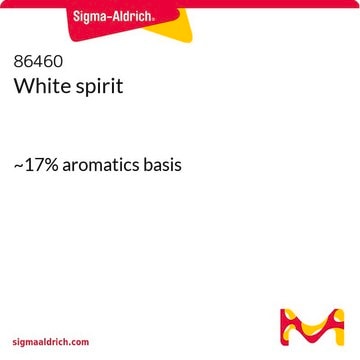334111
Dipentene
technical, for use as solvent (for the paint industry), mixture of various terpenes
Synonyme(s) :
(±)-Limonene, p-Mentha-1,8-diene
About This Item
Produits recommandés
Qualité
for use as solvent (for the paint industry)
technical
Densité de vapeur
>4.7 (80 °C, vs air)
Pression de vapeur
1 mmHg ( 20 °C)
Forme
liquid
Température d'inflammation spontanée
458 °F
Composition
Major isomer: 3-Carene
Minor isomers: Limonene, β-pinene and α-pinene
Limite d'explosivité
0.7-6.1 %, 150 °F
Indice de réfraction
n20/D 1.473 (lit.)
Point d'ébullition
170-180 °C (lit.)
Densité
0.86 g/mL at 20 °C (lit.)
Chaîne SMILES
CC(=C)C1CCC(C)=CC1
InChI
1S/C10H16/c1-8(2)10-6-4-9(3)5-7-10/h4,10H,1,5-7H2,2-3H3
Clé InChI
XMGQYMWWDOXHJM-UHFFFAOYSA-N
Vous recherchez des produits similaires ? Visite Guide de comparaison des produits
Description générale
Application
Autres remarques
Mention d'avertissement
Warning
Mentions de danger
Conseils de prudence
Classification des risques
Aquatic Acute 1 - Aquatic Chronic 1 - Flam. Liq. 3 - Skin Irrit. 2 - Skin Sens. 1
Code de la classe de stockage
3 - Flammable liquids
Classe de danger pour l'eau (WGK)
WGK 2
Point d'éclair (°F)
109.4 °F - closed cup
Point d'éclair (°C)
43 °C - closed cup
Équipement de protection individuelle
Eyeshields, Faceshields, Gloves, type ABEK (EN14387) respirator filter
Certificats d'analyse (COA)
Recherchez un Certificats d'analyse (COA) en saisissant le numéro de lot du produit. Les numéros de lot figurent sur l'étiquette du produit après les mots "Lot" ou "Batch".
Déjà en possession de ce produit ?
Retrouvez la documentation relative aux produits que vous avez récemment achetés dans la Bibliothèque de documents.
Les clients ont également consulté
Notre équipe de scientifiques dispose d'une expérience dans tous les secteurs de la recherche, notamment en sciences de la vie, science des matériaux, synthèse chimique, chromatographie, analyse et dans de nombreux autres domaines..
Contacter notre Service technique

















